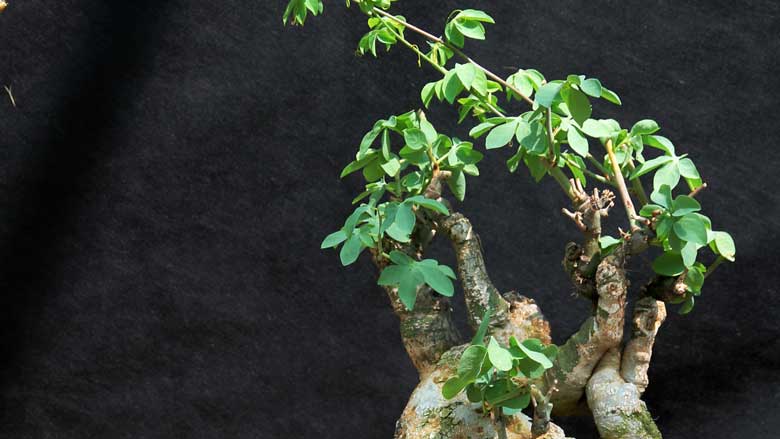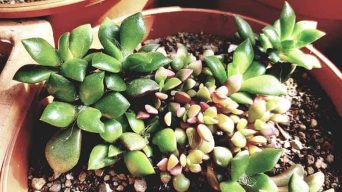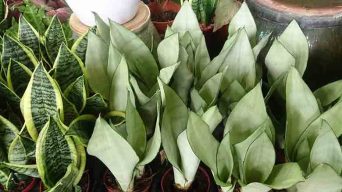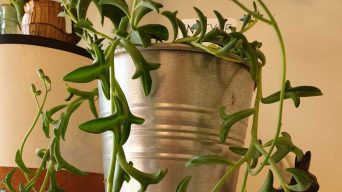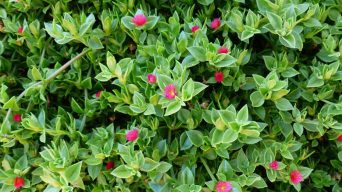Growing Adenia glauca plants is easy, but there are some things you need to know about caring for them.
This article will teach you everything there is to know about Adenia glauca care and propagation.
We’ll go over how to take care of Adenia plants, as well as some tips on propagating Adenia plant cuttings.
Overview
The Adenia genus is a type of flowering plant that belongs to the Passifloraceae family.
Adenia glauca succulents are perennial plants originating in some areas of South Africa and Madagascar.
One of the most distinctive features of Adenia glauca is its fat trunk tree-like base.
This Adenia species will grow to a width of 3.3 feet (1 m) and produce vines up to 10 feet (3 m) when fully mature.
The leaves are pale green, and they get progressively smaller towards the tips. In spring, the plants produce a sparse amount of yellow-green flowers.
How To Care for Adenia Glauca
Sun Exposure & Light Requirements
Adenia glauca is best suited to a bright, sunny spot indoors or outside.
These plants thrive in tropical and subtropical climates. Still, they can also be grown as a houseplant year-round with enough light.
They require full sun for most of the time during the day, so they should be placed where they will get the most light, preferably in a south or west-facing window.
Adenia glauca plants require exposure to five to eight hours of direct sunlight daily.
Although Adenia glauca can be grown outdoors all year long if given enough light and water, they are considered frost sensitive, so care should be taken when placing them outside during colder months.
Watering Requirements
The Adenia glauca succulent needs to be watered about once a week.
It should be given enough water, but the soil shouldn’t be saturated either.
The soil should dry out in between watering sessions.
The Adenia glauca succulent plant does not need to be watered in the winter.
It should only be given water when it is actively growing, which will happen from spring through summer.
Soil Requirements
Adenia Glauca requires a fast-draining soil mix.
You can make your own mix by combining sand and perlite or vermiculite, or you can use a cactus or succulent mix with more sand than fertilizers.
In the end, it is up to personal preference as they all provide sufficient drainage if appropriately mixed.
Temperature and Humidity
Adenia Glauca needs a relative humidity of 60-70% and should be kept at 68 degrees Fahrenheit.
The succulent mustn’t get too cold or warm because it would cause damage to its tissues, which can lead to death due to rot (fungal infection).
This means Adenia Glauca should never be placed outside during winter in areas below 50 degrees Fahrenheit.
In hotter weather, Adenias like more air circulation either from fans or open windows, so they don’t overheat indoors.
Fertilizing
Adenias are slow-growing plants that do not need much fertilizer. They need to be fertilized only during the active growth season.
Fertilize Adenia plants starting in the spring when they’re coming out of dormancy, and then again every few weeks during their active growing season
Use a time-release fertilizer diluted to half strength.
If you plant Adenia outdoors, use a granular type that is applied around the base or root area of plants with an application spreader.
For indoor Adenia plants, fertilize once per month using a water-soluble houseplant fertilizer diluted by one quarter.
Potting and Repotting
When Adenia glauca plants are getting too large for the pot, it might be time to repot them. It would be best if you repotted your Adenia glauca succulent during the active growth season.
To do this, you will need a new well-draining pot with fresh potting soil.
Place the Adenia glauca plant into a new pot, making sure not to damage the roots in the process.
Fill up any spaces at the top of the Adenia with fresh potting mix and water well until it is saturated but not soggy.
Place the Adenia plant in a location with lots of natural light.
Pruning
Adenia glauca needs little pruning and is straightforward to maintain. You just need to remove dead leaves and stems.
You can also remove new growth that emerges from the Adenia if you don’t want them.
Don’t worry about Adenia glauca growing too large because they don’t grow quickly and can be easily trimmed.
Pests and Diseases
Adenia glauca is vulnerable to pests, such as aphids, spider mites, and mealybugs. The most common diseases are rot and leaf spot.
To protect Adenia glauca from aphids, spider mites, and mealybugs, prune off infested leaves and branches.
You can also use insecticidal soap spray, neem oil, or horticultural oils to control Adenia glauca pests.
To protect Adenia glauca from rot and leaf spot, ensure the soil is properly drained by using a well-drained potting mix or gravel at the bottom of your pot.
Water only when the surface of the soil feels dry to touch. This will also help to prevent Adenia glauca from becoming infected.
How to Care for Adenia Glauca in Winter
Winter is here, and it’s time to take care of Adenia glauca plants!
Below are a few tips on how you can winterize your Adenia plants in the colder months.
- Keep Adenia glauca out of drafts or any other extreme temperature changes. You may want to move them from an outside area into your home for the season, but try not to let them be exposed to cold temperatures for long periods.
- If possible, keep Adenia plants dry during this period as they are sensitive to excess water. Overwatering will kill Adenia glauca quickly in wintertime.
- Don’t fertilize Adenia plants during the winter, as they need much less food than usual due to their dormant state.
- Finally, Adenia glauca should not experience frostbite. If your Adenia glauca plants are outside and likely exposed to night temperatures below freezing for prolonged periods, then it’s best to bring it inside where it will be safe.
How To Propagate Adenia Glauca
Adenia Glauca plants are most successfully propagated from seeds.
They can be propagated from seeds by placing these into pots filled with moistened potting mix.
Some people will soak Adenia plant seed overnight to soften up their outer shell, so they’re easier to sow or germinate.
This is not necessary though if you have fresh Adenia plants that are still wet and juicy on the inside when harvesting some seeds off of them, just simply sowing.
These plants can also be propagated from cuttings, but these are less successful than seed propagation.
To propagate Adenia glauca from cuttings:
- Use clean, sharp sheers or gardening scissors.
- Cut just below a node (where leaves meet the stem) to avoid wounding or damaging any other leaves on the plant.
- Let the cuttings dry out for a few hours before planting them in soil.
- Plant the Adenia glauca cutting about an inch below the surface of the potting mix, with only its leaves above ground.
- Water well and place it in indirect but bright light (such as under artificial lights).
- Transplant the Adenia glauca cutting after a couple of months, before it has grown too large.
Is the Adenia Glauca Toxic?
Adenia glauca plants can be highly toxic to humans and animals when consumed or handled improperly.
They are toxic when eaten by humans or animals due to the sap found on their leaves.
Some people do not consider Adenia glauca plants toxic, but they are still poisonous and should be handled with care.
It’s always recommended using gloves when handling Adenia glauca plants.
If the Adenia glauca is eaten or handled improperly, it can cause serious skin irritation, severe stomach pains, and vomiting in humans and animals alike.
Final Thoughts
Adenia glauca care is quite forgiving. It has been shown as one of the most durable plants in all places with different climates and living conditions.
Adenia glauca makes an excellent houseplant as it grows well indoors.
Although they are mainly grown outside, if you’re looking for a houseplant to grow on your windowsill or in the garden, Adenia glauca is perfect!
All in all, Adenia glauca is an excellent addition to any indoor or outdoor succulent garden!

